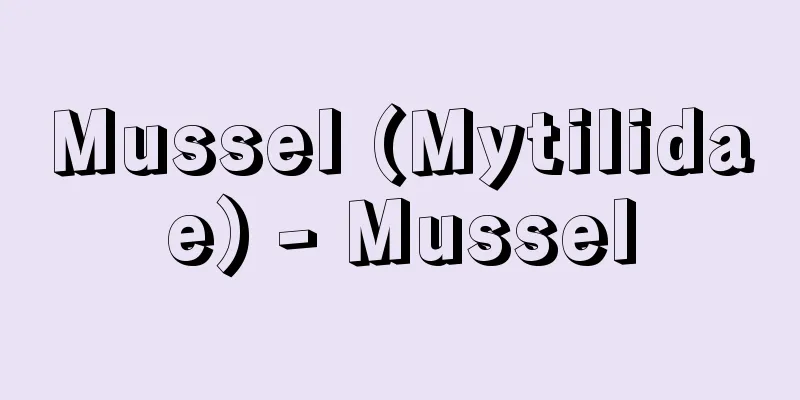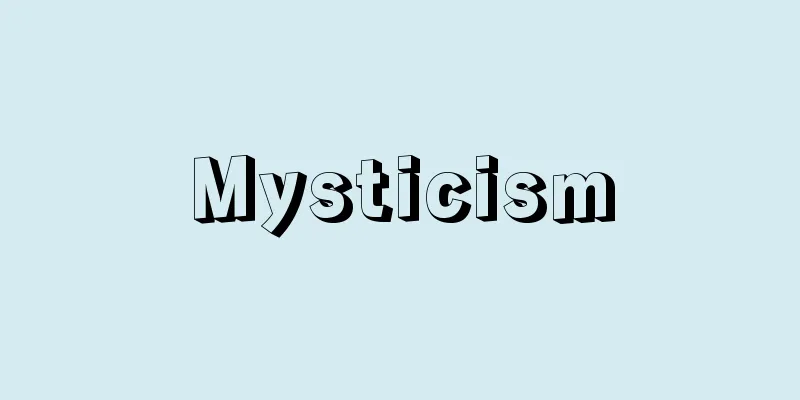Chlorine - Chlorine

|
It belongs to group 17 of the periodic table and is one of the halogen elements. It was the first halogen element to be discovered. historyIn 1774, the Swedish scientist Scheele discovered that a yellow-green gas was produced when hydrochloric acid was oxidized with manganese dioxide. In 1810, the British scientist H. Davy concluded that it was a new element and named it after the Greek word chloros, which means yellow-green. The Japanese word chlorine is based on the fact that it is a component of sodium chloride (NaCl), a typical salt. [Kenichi Morinaga and Katsunori Nakahara] ExistenceIt does not exist in a free state, but exists mainly in seawater and rock salt as salts of alkali metals and alkaline earth metals (NaCl, KCl, MgCl2 , etc.). Its natural isotopic composition is 35 Cl (75.4%) and 37 Cl (24.6%). [Kenichi Morinaga and Katsunori Nakahara] Manufacturing methodIndustrially, chlorine is mainly produced by electrolysis of salt solutions (diaphragm process) and by electrolysis of molten chlorides. In the laboratory, chlorine is produced by oxidizing hydrochloric acid with strong oxidizing agents such as manganese dioxide or potassium permanganate, by thermal decomposition of heavy metal chlorides, or by the action of hydrochloric acid on bleached powder Ca(OCl)Cl. Chlorine is sold commercially in yellow cylinders. [Kenichi Morinaga and Katsunori Nakahara] natureAt room temperature, it is a yellow-green, toxic gas with a pungent odor, and when cooled, it turns from a yellow liquid to a yellow-white solid. It dissolves quite well in water. When the aqueous solution is cooled to 0°C, it becomes a clathrate compound (inclusion compound), hydrate Cl2 · 7.7H2O . Water saturated with chlorine gas is called chlorine water, and is a yellow-green solution. It has a bleaching effect, and hydrochloric acid and hypochlorous acid are produced in the solution. This hydrolysis reaction proceeds 100% in a cold alkaline hydroxide solution. Chlorine is very chemically active, and directly combines with all elemental elements other than inert gases, oxygen, nitrogen, and carbon to form chlorides. When mixed with hydrogen, it does not react as it is, but when the reaction is induced by light, heat, or an electric spark, the reaction proceeds explosively (chain reaction), so the mixture of hydrogen and chlorine is called chlorine detonation gas. There are various types of compounds, and they have oxidation numbers from -I to +VII, but most of them are odd numbers. In chlorides, where chlorine is combined with a more electropositive element, the oxidation state of chlorine is -I. Oxides include dichlorine monoxide (Cl 2 O), chlorine dioxide (ClO 2 ) , dichlorine hexoxide (Cl 2 O 6 ) , and dichlorine heptaoxide (Cl 2 O 7 ) , all of which are unstable and explosive. Oxoacids include hypochlorous acid (HClO) (+I), chlorous acid (HClO 2) (+III), chloric acid (HClO 3) (+V), and perchloric acid (HClO 4 ) (+VII), and there are also salts of each (the oxidation state is shown in parentheses). Interhalogen compounds such as iodine chloride (ICl) are also known. [Kenichi Morinaga and Katsunori Nakahara] ApplicationsIt is used in large quantities for disinfecting tap water and wastewater and for bleaching, and has a wide range of uses as a raw material for manufacturing many inorganic chlorides such as hydrochloric acid and bleaching powder, and organic chlorine compounds (pesticides, pharmaceuticals, explosives, fluorocarbons, vinyl chloride, etc.). [Kenichi Morinaga and Katsunori Nakahara] toxicityChlorine was used as a poison gas in World War I. The harmless limit for chlorine to the human body is said to be 1 ppm. Just 0.003 to 0.006% in the air can affect mucous membranes, causing rhinitis, tears, and coughing. Inhaling it for a long period of time can cause chest pain, blood vomit, and difficulty breathing. In places with high chlorine concentrations, it can cause difficulty breathing and cyanosis, leading to death, so care must be taken not to inhale it directly. [Kenichi Morinaga and Katsunori Nakahara] Chlorine in the human bodyMost chlorine is ingested as table salt (NaCl). 90% of the chlorine in the human body exists as chloride ions, a component of blood and other body fluids, where it is involved in regulating osmotic pressure and maintaining the hydrogen ion concentration index (pH). Some is also secreted into the stomach along with gastric juices as hydrochloric acid, a component of gastric acid. Gastric acid is necessary for the activation of pepsin, a protein-digesting enzyme, and also kills unnecessary bacteria in food. This killing has the effect of facilitating the growth of beneficial bacteria in the intestines. [Tomomi Kono and Yonago Yamaguchi] "Chlorine White Paper" edited by IUPAC and supervised by Junichi Miyamoto (2000, Chemical Daily Press)" ▽ "Encyclopedia of Minerals" edited by Yoshinori Itokawa (2003, Asakura Publishing) [Reference items] | | | | |Table | | [Supplementary information] |©Shogakukan "> Periodic Table Source: Shogakukan Encyclopedia Nipponica About Encyclopedia Nipponica Information | Legend |
|
周期表第17族に属し、ハロゲン元素の一つ。ハロゲン元素のなかで最初に発見された元素である。 歴史1774年スウェーデンのシェーレが、塩酸を二酸化マンガンで酸化するとき、黄緑色の気体が発生することをみいだした。1810年イギリスのH・デービーが新元素であることを結論し、ギリシア語で黄緑色を意味するchlorosにちなんで命名した。日本語の塩素は、これが代表的な塩としての塩化ナトリウムNaClの成分であることに基づいている。 [守永健一・中原勝儼] 存在遊離の状態では存在せず、おもに海水や岩塩中にアルカリ金属およびアルカリ土類金属の塩(NaCl、KCl、MgCl2など)として存在する。天然の同位体組成は35Cl(75.4%)、37Cl(24.6%)である。 [守永健一・中原勝儼] 製法工業的には、おもに食塩水の電解(隔膜法)によって、また融解塩化物の電解によって製造される。実験室では、塩酸を二酸化マンガンや過マンガン酸カリウムなどの強力な酸化剤で酸化するか、重金属塩化物を熱分解するか、あるいはさらし粉Ca(OCl)Clに塩酸を作用させるなどの方法が行われる。塩素は黄色のボンベに詰めて市販される。 [守永健一・中原勝儼] 性質常温で黄緑色、刺激臭のある有毒気体で、冷却すると黄色液体を経て黄白色の固体となる。水にかなりよく溶ける。水溶液は0℃に冷却するとクラスレイト化合物(包接化合物)である水和物Cl2・7.7H2Oが得られる。塩素ガスを飽和させた水は塩素水といい、黄緑色の溶液である。漂白作用があり、溶液中には塩酸と次亜塩素酸を生じている。この加水分解反応は冷たい水酸化アルカリ溶液中で100%進む。塩素は化学的に非常に活発で、不活性気体、酸素、窒素、炭素以外のすべての元素単体と直接化合して、塩化物をつくる。水素と混ぜてもそのままでは反応しないが、光、熱、電気火花などで反応が誘導されると、爆発的に反応が進む(連鎖反応)ので、水素と塩素との混合気体を塩素爆鳴気という。いろいろな種類の化合物があり、-Ⅰから+Ⅶまでの酸化数をとるが、おもに奇数の場合が多い。塩素が、より陽性の強い元素と化合した塩化物中では、塩素の酸化数は-Ⅰである。酸化物には、一酸化二塩素Cl2O、二酸化塩素ClO2、六酸化二塩素Cl2O6、七酸化二塩素Cl2O7があるが、いずれも不安定で爆発性がある。オキソ酸には、次亜塩素酸HClO(+Ⅰ)、亜塩素酸HClO2(+Ⅲ)、塩素酸HClO3(+Ⅴ)、過塩素酸HClO4(+Ⅶ)があり、それぞれの塩もある(括弧(かっこ)内は酸化数)。塩化ヨウ素IClのようなハロゲン間化合物なども知られている。 [守永健一・中原勝儼] 用途水道水や汚水の殺菌および漂白などに多量に用いられるほか、塩酸、さらし粉など多数の無機塩化物や、有機塩素化合物(農薬、医薬、爆発薬、フロン、塩化ビニルなど)の製造原料として広い用途がある。 [守永健一・中原勝儼] 毒性塩素は第一次世界大戦で毒ガスとして用いられた。 塩素の人体に対する無害の限度は1ppmであるという。空気中に0.003~0.006%存在するだけで粘膜が冒され、鼻炎をおこし、涙、咳(せき)などが出る。長時間吸入すると胸が痛み、血を吐いて呼吸困難となる。塩素濃度の高いところでは、呼吸困難とともにチアノーゼをおこして死に至るので、直接吸わないように注意が必要である。 [守永健一・中原勝儼] 人体に含まれる塩素塩素の多くは食塩NaClとして摂取される。人体の塩素の90%は、塩素イオンとして、血液、そのほかの体液の成分として存在し、浸透圧の調節や水素イオン濃度指数(pH)の維持にかかわっている。また、一部は、胃酸の構成部分である塩酸として、胃液とともに胃の中に分泌される。胃酸は、タンパク質消化酵素であるペプシンの活性化に必要であり、また、食物中の不用な菌類の殺菌の働きがある。この殺菌によって、腸内での有用細菌の発育を容易にする効果がある。 [河野友美・山口米子] 『IUPAC編、宮本純之監訳『塩素白書』(2000・化学工業日報社)』▽『糸川嘉則編『ミネラルの事典』(2003・朝倉書店)』 [参照項目] | | | | | | | [補完資料] |©Shogakukan"> 周期表 出典 小学館 日本大百科全書(ニッポニカ)日本大百科全書(ニッポニカ)について 情報 | 凡例 |
Recommend
Odria, M.
...In other words, in a highly professionalized m...
Blood
Blood is the red fluid tissue that flows through ...
Arginine phosphate (arginine phosphate)
Arginine phosphate was discovered in the muscles o...
Eschdorf - Eschdorf
...That is to say, the most common settlements we...
Kyogen book - Kyogenbon
A script for Kyogen. It is usually called a densho...
Sumithion (English spelling)
Organophosphate insecticide (organophosphate prepa...
Epitaphios (English spelling)
In ancient Athens, a funeral oration was a speech ...
Science - kagaku (English spelling) science
Ancient and Medieval Natural Science Since ancien...
Kramer, PL
...However, from the viewpoint of architectural t...
Mahillon, VC (English spelling)
…While he had detailed data on individual instrum...
Lerista stylis (English spelling) Leristastylis
…[Hiroshi Aramata]. … *Some of the terminology ex...
Aluminum sash - Almisash
...The largest of these are steel frames and brid...
Home - katei (English spelling)
The living space and atmosphere of individuals ce...
Alcatraz Island (English spelling)
A small island in San Francisco Bay in western Cal...
Test tube baby - Test tube baby
〘Noun〙 (Baby is baby) A baby that has been artific...





![Sagamiko [town] - Sagamiko](/upload/images/67cba82cabd51.webp)



![Kuchinotsu [town] - Kuchinotsu](/upload/images/67cb69820afd4.webp)